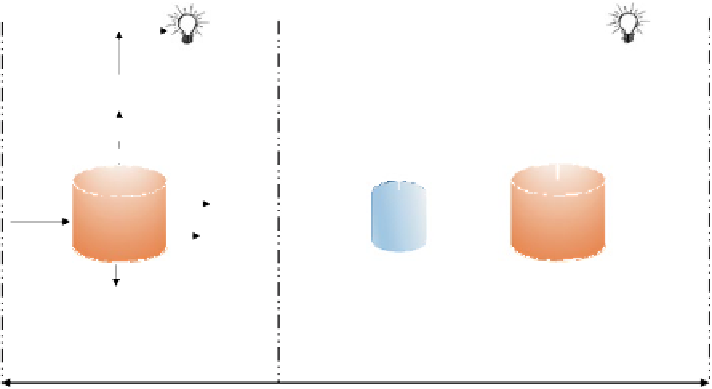Environmental Engineering Reference
In-Depth Information
H
2
CH
4
H
2
CH
4
CH
4
CH
4
CH
4
+ CO
2
CH
4
+ CO
2
CH
4
+ CO
2
CH
4
+ CO
+
2
H
2
+ CO
2
H
2
+ CO
+
2
VFA
VFA
Sludge
Sludge
C
6
H
12
O
6
+ 2H
2
O
C
6
H
12
O
6
+ 2H
2
O
Sludge
Methane diges
on
process
C
6
H
12
O
6
Methane diges
on
process
Hydrogen
fermenta
on
Organic
ma
er
Organic
ma
er
Wastewater
Wastewater
Organic
ma
er
Wastewater
W
4H
2
+ 2CH
4
+ 4CO
2
1.144KJ + 1.247KJ =
2.391
KJ
3CH
4
+ 3CO
2
1.871
KJ
Single phase technology
Two phase technology
Fig. 8.19
Total energy gained from single phase and two phase processes
in a well operated process, these products are mostly converted to acetic acid and
hydrogen (see Eqs. 8.2, 8.3), which, in turn, are converted to methane gas in a two-
phase anaerobic process (see Eqs. 8.8, 8.9).
Methane fermentation
(
)
C H
O
→+
3CH
3CO
2673
kJ mol
/
(8.7)
6
12
6
4
2
H
2
+ CH
4
fermentation
C H
O
+→++
2H O
4H
2CO
2CH COOH
6
12
6
2
2
2
3
2CH COOH
→+
2CH 2CO
(8.8)
3
4
2
(
)
C H
O
+→++
2H O
4H
2CH
4CO
2926kJ / mol
(8.9)
6
12
6
2
2
4
2
Separating the acidogenic and methanogenic steps in the anaerobic digestion
process, provides enhanced stability to the different groups of microorganisms
and better process control. However, despite their higher loading rates, improved
process stability and flexibility, there are few commercial two-stage anaero-
bic digestion units. The added complexity and expense of building and operat-
ing commercial two-stage systems have so far counteracted the yield and rate
enhancements. The theoretically higher biogas yields have also been questioned
since the acidogenic phase separation prevents the hydrogen to methane pathway
(Reith et al.
2003
).



































































